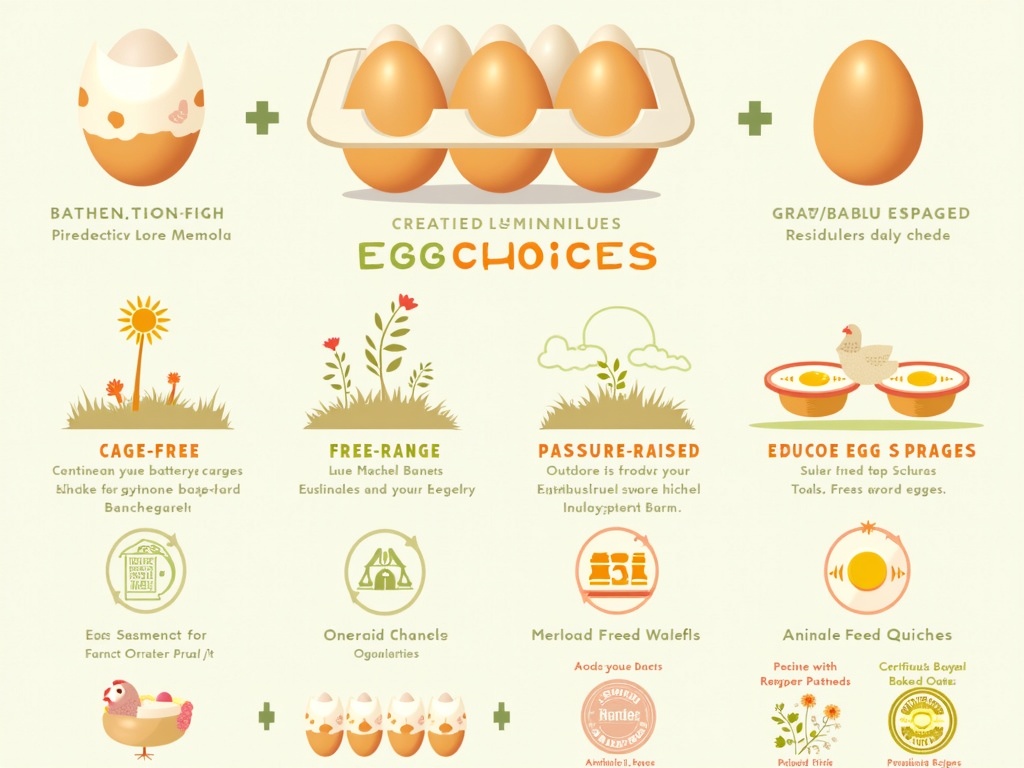Egg dishes serve as one of the most versatile and nutritionally dense foods in global cuisine, offering impressive protein content and essential micronutrients in an economical package. From simple breakfast scrambles to elaborate international dishes like shakshuka and tamagoyaki, eggs adapt to countless cooking techniques while providing sustainable protein options when sourced responsibly.
Find In This Article
Key Takeaways
- Eggs are nutrient powerhouses containing high-quality protein, vitamin D, vitamin B12, choline, and selenium while being relatively low in calories and carbohydrates.
- Mastering cooking techniques like proper poaching, low-heat scrambling, and precise timing for boiled eggs significantly enhances egg dish quality and nutrient preservation.
- Recent nutritional research has revised previous concerns about dietary cholesterol, with most health organizations now supporting moderate egg consumption as part of a balanced diet.
- Sustainable egg choices include looking for third-party certifications like Certified Humane, considering local sources, and understanding label terms like “cage-free” versus “free-range.”
- Egg consumption trends are evolving with growing markets for specialty eggs, plant-based alternatives, and convenient preparations like egg muffins and mini quiches for meal prep.
The Health Benefits That Make Eggs a Superfood
Eggs are truly nutritional powerhouses packed into a small shell. One large egg contains just 70 calories while delivering an impressive 6 grams of protein, 5 grams of fat, and less than 1 gram of carbohydrates. This macronutrient profile makes eggs an excellent choice for anyone looking to maintain a balanced diet without overloading on calories.
I’ve found eggs to be one of the most versatile ingredients in my kitchen, perfect for creating everything from a simple egg sandwich for breakfast to elegant mini quiches for brunch gatherings.
Nutrient Density That’s Hard to Beat
The micronutrient content of eggs is where they really shine. They’re rich sources of vitamin D, which is crucial for bone health and immune function. Eggs also provide significant amounts of vitamin B12, essential for nerve function and red blood cell formation. The choline content in eggs supports brain health and development, while selenium acts as a powerful antioxidant in the body.
When comparing protein sources, eggs consistently come out on top in terms of economic value. According to protein comparison studies, eggs are the most economical high-quality protein source when measured against alternatives like chicken breast or tofu. This makes them particularly valuable for families on a budget who don’t want to compromise on nutrition.
The scale of egg production reflects their popularity and importance in our diets. USDA data shows that the US produces an astonishing 89 million eggs daily as of 2022. This massive production meets the demand for this versatile ingredient used in countless recipes from egg muffins to American pancakes.
For those concerned about heart health, it’s worth noting that the American Heart Association has revised its stance on eggs in recent years. They now approve the consumption of 1 whole egg or 2 egg whites daily for most healthy individuals. This updated guidance reflects the growing scientific consensus that the cholesterol in eggs doesn’t significantly impact blood cholesterol levels for most people.
I’ve incorporated eggs into my diet in numerous creative ways beyond the basic breakfast scramble. They’re fantastic additions to:
- Baked oats for added protein and a custard-like texture
- Grain bowls topped with a soft-boiled egg for extra richness
- Homemade salad dressings for emulsification and creaminess
- Vegetable-packed frittatas for make-ahead weekday lunches
- Toast sandwiches with avocado and a fried egg for quick meals
The beauty of eggs lies not just in their nutritional profile but in their ability to transform almost any dish. Their binding properties make them essential in baking, while their protein content makes them satisfying as a main dish.
For anyone looking to improve their diet without breaking the bank, eggs represent one of the most accessible superfoods available. Their combination of complete protein, healthy fats, vitamins, and minerals is difficult to match in such a compact, affordable package.

Must-Know Cooking Techniques for Perfect Eggs
Mastering egg cooking techniques can transform your breakfast experience. I’ve spent years perfecting these methods, and I’m excited to share the secrets to consistently delicious results. Whether you’re preparing a quick egg sandwich or an elaborate brunch, these fundamentals will help you achieve egg perfection every time.
Essential Egg Cooking Methods
Hard-boiled eggs require precision timing for the perfect texture. I start with eggs at room temperature, then place them in a pot of cold water. Once the water reaches a rolling boil, I reduce to a simmer and set my timer. For slightly jammy centers, 9 minutes works beautifully, while firm yolks need 11-12 minutes. The key is transferring them immediately to an ice bath afterward to stop the cooking process and make peeling easier.
Poaching can be intimidating, but it’s actually straightforward. I bring a pot of water to a gentle simmer (not a boil) and add a tablespoon of vinegar. The vinegar helps the egg whites coagulate quickly. Creating a gentle whirlpool in the water before sliding in the egg helps form that perfect rounded shape. Fresh eggs work best for poaching, as the whites stay more compact. These poached eggs are perfect atop toast or as part of eggs Benedict.
For scrambled eggs, low heat is the secret. I crack eggs into a bowl, add a splash of milk or cream, and whisk until just combined. Using a non-stick pan on low heat, I gently fold the eggs with a silicone spatula. Constant, gentle movement creates those soft, creamy curds. Removing the pan from heat just before the eggs are fully set allows residual heat to finish the cooking without overdoing it.
Baking eggs opens up countless possibilities. I use this method for mini quiches and frittatas. Typically, a 350°F oven works well for most egg bakes. For egg muffins, I bake at 375°F for about 20 minutes until just set in the center. The beauty of baked eggs is their versatility with mix-ins and their make-ahead convenience.
When troubleshooting common egg issues, I’ve found that rubbery hard-boiled eggs usually mean they’re overcooked. For poaching problems, eggs that spread out too much in the water aren’t fresh enough. Scrambled eggs turning out dry typically means the heat was too high or they cooked too long. For baked eggs, a water bath can prevent cracking and promote even cooking.
To retain maximum nutrients when cooking eggs, I limit high-heat exposure when possible. Gentle cooking methods like poaching and soft-boiling preserve more B vitamins than high-heat methods. Pairing eggs with vegetables in dishes like frittatas also helps you absorb more fat-soluble nutrients from both ingredients.
These egg cooking techniques pair wonderfully with other breakfast favorites. Try serving your perfectly cooked eggs alongside American pancakes for a classic breakfast combo, or incorporate them into baked oats for a protein-packed morning meal.
I’ve found that practice makes perfect with egg cooking. Start with these fundamental techniques, pay attention to timing and temperature, and you’ll soon develop an intuition for creating perfectly cooked eggs every time. The versatility of eggs makes them worth mastering – they can be the star of breakfast or add protein and richness to countless dishes throughout the day.

Global Egg Dishes That Will Expand Your Culinary Horizons
I’ve discovered that eggs are truly universal, appearing in delicious forms across every culture. From basic breakfast staples to complex dinner centerpieces, these protein-packed wonders adapt to regional ingredients and cooking techniques.
Classic Egg Preparations with Global Twists
Scrambled eggs take on fascinating regional personalities worldwide. In France, they’re cooked slowly over low heat with plenty of butter for a creamy, soft-set texture. Meanwhile, Indian versions (bhurji) incorporate onions, tomatoes, chilies, and aromatic spices like turmeric and cumin.
Omelettes demonstrate incredible versatility across cultures. The French perfected the delicate, barely-set center style, while American diners popularized fully-cooked, stuffed versions. I’ve found that Japanese tamagoyaki (rolled omelette) offers a sweet-savory balance using dashi, sugar, and soy sauce.
Quiche remains one of my favorite versatile egg dishes. This French classic combines eggs and cream in a pastry shell with limitless filling possibilities. The mini quiche recipe I make allows for individual portions perfect for brunches or appetizers. Quiche works beautifully served either hot from the oven or chilled for picnics.
Distinctive Cultural Egg Specialties
Shakshuka showcases eggs in an entirely different light. This Middle Eastern treasure features eggs poached directly in a spiced tomato sauce with bell peppers, onions, and spices like cumin and paprika. The runny yolks mix with the sauce to create a perfect dipping sauce for bread.
South Asian egg curry transforms hard-boiled eggs into a flavorful main dish. The eggs absorb a rich gravy made with onions, tomatoes, garlic, ginger, and garam masala. Each region has its variation – some fiery hot, others mild and creamy with coconut milk.
For a portable breakfast option, egg muffins combine the convenience of meal prep with endless customization possibilities. Similarly, the humble egg sandwich recipe takes different forms globally – from Japanese tamago sando with kewpie mayo to Indian egg bhurji sandwiches spiced with green chilies.
For sweeter egg applications, I’ve found American pancakes and baked oats offer comforting breakfast options where eggs provide structure rather than starring flavor. The simple toast sandwich can be elevated with a perfectly fried egg and seasonings.
The cultural significance of eggs cannot be overstated. In many traditions, they symbolize fertility and rebirth, which explains their prominence in spring celebrations across various cultures. Understanding authentic preparation methods helps preserve culinary heritage while allowing for creative modern interpretations.
Modern Trends Reshaping How We Eat Eggs
The Evolution of Egg Consumption
I’ve noticed a significant shift in how eggs are being consumed today. Plant-based alternatives have gained impressive traction, with innovative products using mung beans and pea protein that mimic the texture and protein content of traditional eggs. These alternatives cater to those with dietary restrictions or ethical considerations while still delivering familiar flavors.
Gourmet preparations have also transformed ordinary egg dishes into culinary experiences. Truffle scrambled eggs, once reserved for high-end restaurants, have found their way into home kitchens. The earthy aroma of truffle pairs perfectly with the creamy texture of well-prepared eggs, elevating a simple egg sandwich or breakfast plate to something special.
Convenience has become a driving factor in egg consumption patterns. Meal prep options like egg muffins and mini quiches have surged in popularity as they offer protein-packed options that can be prepared in advance and consumed throughout the week.
Health-Focused Approaches to Eggs
The demand for healthier egg options continues to grow steadily. Consumers are increasingly looking for eggs with improved nutritional profiles, including those enriched with omega-3 fatty acids or from pasture-raised hens. This health-conscious approach extends to preparation methods too, with baked oats containing eggs gaining popularity as a nutritious breakfast option.
Market data clearly shows this shift in consumer preferences. Sales of specialty eggs have increased by 13% year-over-year, while traditional egg sales have remained relatively flat. Meanwhile, plant-based egg alternatives have seen explosive growth, with a 42% increase in market share over the past two years.
The versatility of eggs continues to inspire creative culinary innovations. From reimagined classics like toast sandwiches with perfectly poached eggs to international influences bringing new egg preparations to mainstream breakfast tables, eggs remain a cornerstone ingredient that’s evolving with changing tastes.
For those looking to experiment with eggs beyond the basic scramble, American pancakes with egg whites folded in for extra fluffiness offer a fun twist on a breakfast staple. This technique demonstrates how even traditional dishes can be enhanced through thoughtful egg incorporation.
The egg landscape continues to expand, offering more choices than ever for every preference, dietary need, and culinary ambition.
Making Sustainable Choices with Eggs
I’ve looked into the environmental footprint of eggs, and the numbers are eye-opening. Each dozen eggs produces approximately 3.3 kg CO2 equivalent, which puts them lower on the climate impact scale compared to many animal proteins. This makes eggs a relatively sustainable protein choice when selected thoughtfully.
Understanding Egg Production Methods
The way eggs are produced significantly affects their sustainability profile. According to USDA findings, cage-free farming systems generally offer improved animal welfare compared to conventional battery cage operations. In conventional systems, hens have limited space to move and express natural behaviors, while cage-free environments allow birds to walk, spread their wings, and often engage in natural behaviors like dust bathing.
The environmental impact varies between production methods too. Conventional egg farming typically uses less land and has a smaller carbon footprint per egg, but cage-free and free-range systems often score better on biodiversity and soil health metrics. Pasture-raised eggs, where hens roam outdoors eating insects and plants, can even help with natural pest control and soil fertilization.
Making Informed Choices
When shopping for eggs, I find these considerations helpful for making ethical choices:
- Look for third-party certifications like Certified Humane or Animal Welfare Approved that verify farming practices
- Consider buying locally from farmers whose practices you can verify
- Understand that “natural” has no regulated meaning on egg cartons
- Recognize that “cage-free” doesn’t necessarily mean the hens have outdoor access
- Check if “organic” certification is present, which requires specific feed standards and prohibits antibiotics
Making the most of your sustainable egg choices is important too. I try to reduce food waste by planning egg-based meals throughout the week. Egg sandwich recipes provide a quick lunch option, while mini quiches can be prepared in advance for multiple meals.
For breakfast, egg muffins and American pancakes offer versatile options that can incorporate leftover vegetables and reduce kitchen waste. Baked oats with eggs provide a nutritious start to the day with the added benefit of being environmentally mindful.
Even the humble toast sandwich can be elevated with ethically sourced eggs for a sustainable meal option. By making conscious choices about both the eggs we buy and how we use them, I can enjoy this versatile protein while minimizing environmental impact.

Health Considerations and Facts You Should Know
Eggs have been at the center of nutritional debates for decades, particularly regarding their cholesterol content. A large egg contains approximately 186 mg of cholesterol, which once caused health experts to recommend limiting consumption. However, I’ve found that recent research has significantly changed how we view eggs in a healthy diet.
Cholesterol Facts and Misconceptions
The relationship between dietary cholesterol and blood cholesterol isn’t as straightforward as once thought. Research now shows that dietary cholesterol has a limited impact on blood cholesterol levels for most people. Our bodies naturally produce cholesterol, and when we consume more from food, many people’s bodies compensate by producing less.
Health organizations have updated their stance on eggs in recent years. The American Heart Association no longer includes specific cholesterol limits in their dietary recommendations, acknowledging that moderate egg consumption can be part of a heart-healthy diet.
What’s particularly interesting is how the yolk, despite containing cholesterol, offers valuable nutrients that benefit overall health. The lutein and zeaxanthin in egg yolks support eye health, while the choline is essential for brain function. I’ve incorporated egg muffins into my breakfast rotation as a convenient way to get these nutrients.
For those watching their cholesterol closely, consider balancing your diet. Enjoying eggs alongside fiber-rich foods like whole grains in American pancakes or vegetables in a mini quiche recipe can create a nutritionally balanced meal.
Egg Allergies and Sensitivity
Egg allergies affect approximately 2% of children, making them one of the more common food allergies in young people. The good news is that most children outgrow these allergies by age 5, according to allergy research. The proteins in egg whites are typically responsible for allergic reactions, though some individuals react to proteins in the yolk as well.
For those with egg allergies or looking to reduce egg consumption, alternatives exist. Plant-based egg substitutes work well in recipes like baked oats, while aquafaba (the liquid from canned chickpeas) can replace egg whites in many recipes.
I’ve noticed that some people who can’t tolerate eggs in their pure form might be able to eat them when they’re an ingredient in thoroughly cooked dishes. The heating process can alter the allergenic proteins enough to prevent reactions in some individuals.
Adults with newly developed egg sensitivities might benefit from exploring different cooking methods. Sometimes, hard-boiled eggs in an egg sandwich recipe are better tolerated than fried eggs.
For those with no allergies, eggs remain one of the most cost-effective protein sources available. They’re versatile enough to work in everything from a simple toast sandwich to elegant brunch dishes.
The latest nutritional research continues to support moderate egg consumption for most people. The nutrients in eggs, including high-quality protein, vitamins D and B12, and minerals like selenium, contribute positively to overall health when consumed as part of a balanced diet.
The key takeaway I’ve learned is that individual responses to eggs vary, and personal health conditions should guide consumption. While eggs have been unfairly demonized in the past, current science supports their place in a nutritious diet for most people. As with many foods, moderation and variety remain the foundations of healthy eating patterns.
Sources:
USDA Economic Research Service, “Eggs Production Data”
American Heart Association, “Dietary Cholesterol and Cardiovascular Disease”
Food and Agriculture Organization (FAO), “Sustainable Egg Production Report”
Gourmet Magazine, “Rising Trends in Egg Dishes”
National Institutes of Health, “Health Effects of Eggs”

